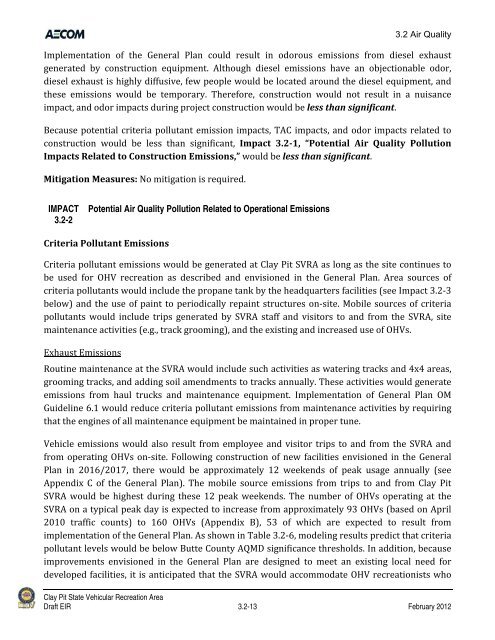Draft Environmental Impact Report - California Off Highway Vehicle ...
Draft Environmental Impact Report - California Off Highway Vehicle ...
Draft Environmental Impact Report - California Off Highway Vehicle ...
You also want an ePaper? Increase the reach of your titles
YUMPU automatically turns print PDFs into web optimized ePapers that Google loves.
3.2 Air Quality<br />
Implementation of the General Plan could result in odorous emissions from diesel exhaust<br />
generated by construction equipment. Although diesel emissions have an objectionable odor,<br />
diesel exhaust is highly diffusive, few people would be located around the diesel equipment, and<br />
these emissions would be temporary. Therefore, construction would not result in a nuisance<br />
impact, and odor impacts during project construction would be less than significant.<br />
Because potential criteria pollutant emission impacts, TAC impacts, and odor impacts related to<br />
construction would be less than significant, <strong>Impact</strong> 3.21, “Potential Air Quality Pollution<br />
<strong>Impact</strong>s Related to Construction Emissions,” would be less than significant.<br />
Mitigation Measures: No mitigation is required.<br />
IMPACT<br />
3.2-2<br />
Potential Air Quality Pollution Related to Operational Emissions<br />
Criteria Pollutant Emissions<br />
Criteria pollutant emissions would be generated at Clay Pit SVRA as long as the site continues to<br />
be used for OHV recreation as described and envisioned in the General Plan. Area sources of<br />
criteria pollutants would include the propane tank by the headquarters facilities (see <strong>Impact</strong> 3.2‐3<br />
below) and the use of paint to periodically repaint structures on‐site. Mobile sources of criteria<br />
pollutants would include trips generated by SVRA staff and visitors to and from the SVRA, site<br />
maintenance activities (e.g., track grooming), and the existing and increased use of OHVs.<br />
Exhaust Emissions<br />
Routine maintenance at the SVRA would include such activities as watering tracks and 4x4 areas,<br />
grooming tracks, and adding soil amendments to tracks annually. These activities would generate<br />
emissions from haul trucks and maintenance equipment. Implementation of General Plan OM<br />
Guideline 6.1 would reduce criteria pollutant emissions from maintenance activities by requiring<br />
that the engines of all maintenance equipment be maintained in proper tune.<br />
<strong>Vehicle</strong> emissions would also result from employee and visitor trips to and from the SVRA and<br />
from operating OHVs on‐site. Following construction of new facilities envisioned in the General<br />
Plan in 2016/2017, there would be approximately 12 weekends of peak usage annually (see<br />
Appendix C of the General Plan). The mobile source emissions from trips to and from Clay Pit<br />
SVRA would be highest during these 12 peak weekends. The number of OHVs operating at the<br />
SVRA on a typical peak day is expected to increase from approximately 93 OHVs (based on April<br />
2010 traffic counts) to 160 OHVs (Appendix B), 53 of which are expected to result from<br />
implementation of the General Plan. As shown in Table 3.2‐6, modeling results predict that criteria<br />
pollutant levels would be below Butte County AQMD significance thresholds. In addition, because<br />
improvements envisioned in the General Plan are designed to meet an existing local need for<br />
developed facilities, it is anticipated that the SVRA would accommodate OHV recreationists who<br />
Clay Pit State Vehicular Recreation Area<br />
<strong>Draft</strong> EIR 3.2-13 February 2012








